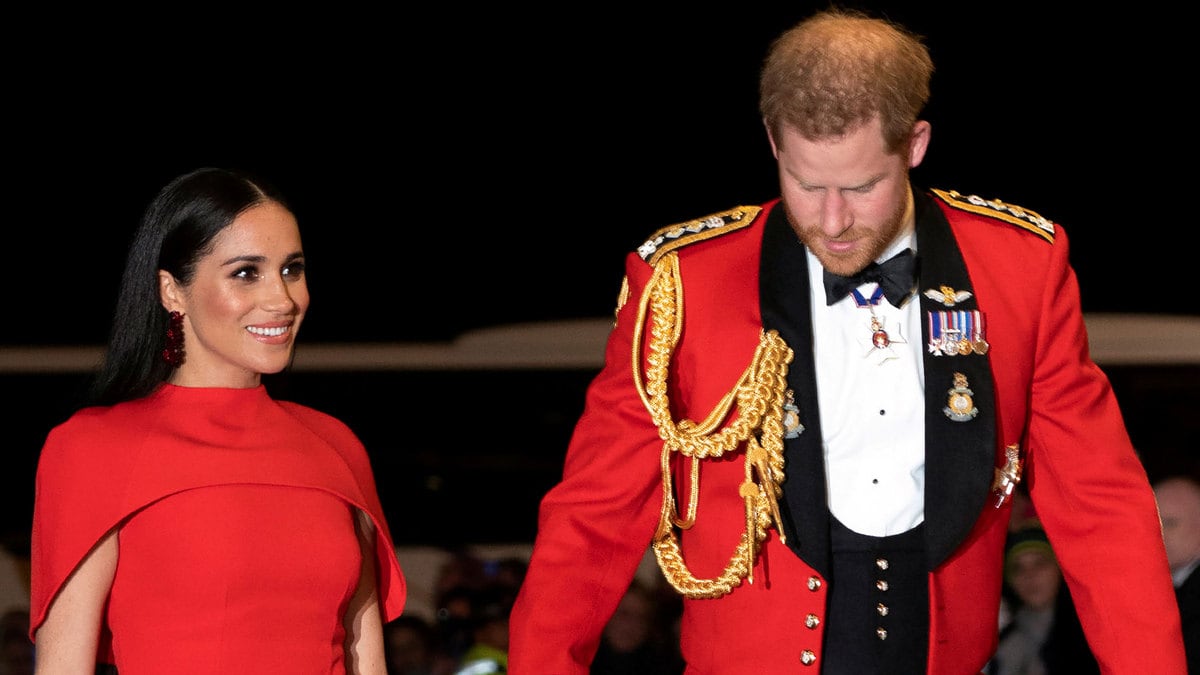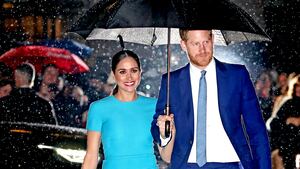If you love The Daily Beast’s royal coverage, then we hope you’ll enjoy The Royalist, a members-only series for Beast Inside. Become a member to get it in your inbox on Sunday.
For mischief’s sake, let’s imagine that the queen and Princess Anne clinked glasses when they triumphantly interrupted Prince Harry and Meghan Markle’s week of grandstanding woe. The oldies can still steal the show when you least expect it.
In a week otherwise marked by the heady fumes arising from a new book, Finding Freedom: Harry and Meghan and the Making of a Modern Royal Family—which can be summarized as “The royals suck, here’s why, and we’re a lot cooler than those saddos”—the queen and Princess Anne showed that sometimes the best royal PR is the silliest.
A clip from a forthcoming documentary about Anne to mark her 70th birthday on Aug. 15 shows the queen’s daughter showing her mother how Zoom works. It was brilliant and charming—and gives royal fans looking for brief respite from all the malign whispering what they really want, which is to spend hours looking at how the royal family decorates their living quarters.
At least in what we see, this typically proves to be charmingly prosaic: sofas that have seen better days, weird little figurines of animals, and jugs of flowers on their fourth day in some water. Yet again, Princess Anne emerges as the Firm’s brisk, quiet star.
As The Daily Beast has noted before, her reputation for rudeness—“Naff off” being her most oft-quoted words—has mellowed to a kind of twinkling truculence, especially when she seemed to diss Donald Trump on his London visit.
This brief spot of levity interrupted a royal week otherwise dedicated to a groaning table of dishes in Harry and Meghan's extravagant anti-royal buffet.
Most naysayers said that Harry and Meghan failed to inflict heavy damage on the family, but that’s missing the point. The depth of evident bad feeling, especially between the two young royal couples—William and Kate and Harry and Meghan—may prove ultimately more corrosive.
The extracts from the book unspooled in The Times of London and U.K. Sunday Times. Meghan claimed to have given up her “entire life” for the royal family. The extracts sketched how the couple felt unheard and roughly treated when they proposed a half-in half-out way of being royal.
Impractical as that might have been, Harry and Meghan saw the palace leaking against them, and the negotiations of their exit as brutal. They also resented no-one acknowledging their global fame, and seeing it is an asset. In their mind the royals were both jealous and unable to deal with what they represented. The negotiations around their departure from the royal family were, for Harry, like facing “a firing squad.”
Harry and Meghan released a statement saying they had not co-operated with the book, and one of its co-authors, Omid Scobie, told The Times they had given no interviews on or off the record.
The oft-repeated statement from Team Sussex this week has been: “The Duke and Duchess of Sussex were not interviewed and did not contribute to Finding Freedom. This book is based on the authors’ own experiences as members of the royal press corps and their own independent reporting.”
If this is true, the level of precise detail, and precisely recalled quotes at moments of high emotion, suggest that Scobie and his co-author, Carolyn Durand, gathered information from particularly well-informed lint on Harry and Meghan’s clothing.
The real hounds of hell were unleashed on William and Kate. The root of the resentment seems to be that William cautioned Harry to take things easily with “this girl,” which Harry saw as snobbish and condescending as opposed to caring and clumsily put.
From there, the brothers’ relationship has spiraled, and while the book is careful not to sketch Meghan and Kate in the old sexist trope as rivalrous women-in-mortal combat, Meghan makes clear that she would have liked Kate to have reached out more and been more welcoming.
When Kate sent Meghan a bunch of flowers “as a peace offering,” it was deemed not enough by Meghan, according to Vanity Fair.
After days of being painted as the hostile couple, William and Kate struck back last weekend to claim that Kate had been welcoming and had even cooked Megan vegan food. Meghan also claimed her father had been “fully corrupted” by the media when he had ended up in league with a paparazzi photographer to stage pictures of himself, prior to her wedding.
The book included word-perfect texts and words said on the phone allegedly from daughter to father, as Meghan desperately tried to get him to the U.K. for her wedding. Then came the revelation of a “senior royal” calling Meghan a “showgirl,”and another one opining that she came with “a lot of baggage.”
Then came Harry’s “incandescent rage” over the racism Meghan allegedly faced, how the couple became “almost obsessed” with each other, and the existence of his private Instagram account. The book places Meghan as a victim of relentless prejudice and snobbery, with Harry furiously trying to protect her and challenge the institution he was born into.
But it all got too much. In the end, inevitably, the queen swiftly took action—ejecting her grandson, while making it clear she loved him over Sunday lunch, and that he and Meghan could come back to the royal fold any time. Clearly, HM is a mafioso in bright florals.
Further extracts in People showed the animosity spilled over—inevitably—into what Meghan wore, with a contretemps over a gold chain with the initials H and M on it. Meghan wore it at the beginning of their relationship, and it so upset the palace “she was advised that wearing such a necklace only served to encourage the photographers to keep pursuing such images—and new headlines,” the book reported.
Meghan was left feeling “frustrated and emotional” by this, a source revealed: “'While she knew the aide had good intentions, the surreal experience of having someone from her boyfriend’s office tell her what kind of jewelry to wear or not to smile at a photographer was too much.”
A “distraught” Meghan then called a friend complaining, “I can’t win. They make out like I’m to blame for these pictures, that it looks like I’m encouraging them, that me even acknowledging the cameras may not be sending the right message. I don’t know what to say. It was only yesterday that people online were saying I look miserable in pictures, because I was trying to just ignore the [photographer].” Meghan “felt damned if she did and damned if she didn't.”
The saga of Meghan’s wedding tiara—a diamond center-stone adorned filigree tiara, borrowed from the queen and originally made for Queen Mary, the Princess of Teck)—was also re-run, to underline that Meghan and the queen didn’t have a beef with each other over the headpiece. This again emphasized the book working to a very strict correct-the-tabloid scorecard.
It was, the book claims, the queen’s dressmaker Angela Kelly who “dragged her feet” over getting things ready in advance of a pre-wedding “hair trial.” (There was a hair-specific wedding day dry run? Amazing.) The saga did not end there, with the Mail reporting the Queen had denied Meghan her choice of tiara.
Meghan and Harry’s critics have gathered, in the days since the book's release, to accuse them of the usual: disrespect, self-centeredness, whininess, and selfishness, particularly in light of where the world finds itself right now.
Certainly, the book is a biting, score-settling exercise, seemingly executed if not by Meghan and Harry, then by people or pieces of lint very close to them, who have been seething over a press cuttings file they violently disagree with. But it is also a manifesto of woe of a young couple determined to change something, even if they are not sure what and how.
Vanity Fair quoted a family source: “The Palace are worried about the book because they know what really happened behind the scenes. Frankly they should be breathing a sigh of relief. It could have been a lot worse. It’s going to open old wounds at a time when everyone wanted to move on. I think the person who will be most upset about it all is the queen.”
“A lot of damage has been done,” Scobie told People.
You can see why. Finding Freedom is not a biography; it is soapy revenge in book form—intended to pay back perceived enemies in both the palace and the media.
The latter is the principal object of Harry and Meghan’s ire. It is telling the book is published not just as they fight multiple legal actions against the fourth estate, but also in the week that Meghan agreed to pay £67,000 ($88,000), having lost the first round of her battle with Associated Newspapers, proprietors of the Mail on Sunday.
That legal battle—Meghan claims an invasion of privacy over published extracts of correspondence sent to her father—is an encapsulation of the central mystery of the book, which is less about who said what at the palace and, if Harry and Meghan are not speaking for Harry and Meghan, who keeps speaking very intimately and knowledgeably on their behalf?
Meghan does not want the identities of friends who spoke to People magazine in her defense after the Mail article came out to be named, arguing this week that “each of these women is a private citizen, young mother, and each has a basic right to privacy.” (Why should one’s age and parental status be relevant here?) For Meghan, naming the women would be “an unacceptable price to pay for the right to pursue her claim for invasion of privacy.”
Both book and court case highlight Harry and Meghan’s determination to swim in some intriguing counter-currents. They want to be spoken about, they want a high profile—but apparently the coverage must be glowing, or cue storm clouds; the words must be sympathetic, or by and from them, or they are to be doubted.
Harry and Meghan are not alone in this desire: famous or not, people want to be thought of in the best way in the public square.
But being in that public square comes with operational risk, and brickbats as well as bouquets. Harry and Meghan do not always get bad press; indeed, they are lionized for some of their work and activism. Yet these two young, rich, beautiful, charismatic people appear furious. They say they want to be for the people and advocate for social change, yet have intense status anxiety. They want to lecture the world, yet recoil from others’ advice.
Is this what Meghan and Harry’s public life will become—inspirational speeches, social activism, empowering speeches (great), contrasted with court appearances and sour, passive-aggressive exchanges with family members via trusted journalists?
If so, Finding Freedom seems an inaccurate title for a book that is squarely focused not on liberation but the complex dynamics, grievances, and punishments of a gilded cage—and one that far from having escaped by decamping to Los Angeles, Meghan and Harry still seem determined to inhabit. The real question the book extracts beg is: What might Harry and Meghan’s real freedom look like?







